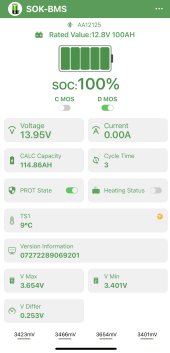Hi Folks,
I know there were some threads in the past on this I've read through. The ones I read didn't seem definitive on this and they were a while back; so I thought I'd post since I'm at a cross roads.
I have 3 - SOK Marine grade 100Ah LiFePo4 batteries that are wired in series for 36v. This is for an electric trolling motor application. I have two chargers I'm bench testing.
1. Minn Kota MK345PCL --- 3 Bank x 15amp Charger - manual profile selection
2. Noco GENPRO10X3 --- 3 Bank x 10Amp charger - manual profile selection
On testing these in the Lithium profile, I see that the Minn Kota has a charge voltage for the Lithium profile of 14.2volts
With the Noco, the Lithium charge profile is 14.6 volts.
The Minn Kota shuts down once the BMS disconnects at full charge or C MOS gets enabled.
The Noco goes to sleep once the BMS disconnects at full charge or C MOS gets enabled...but then it appears to wake up again every few minutes to try to charge, and then goes back into sleep. It appears to continue in this cycle.
At any rate, when I call SOK, they said they really like to see 14.4-14.6v so the cells can be properly balanced.
When I call Minn Kota and ask why did you settle on 14.2v, they blamed the LiFePo4 companies saying, "they many didn't provide the charge voltages in their documentation and therefore, we settled on a 'safe' voltage of 14.2v. If you need 14.4-14.5, you can use the AGM setting."
So I'm at a cross roads. I need an onboard waterproof marine rated charger. I would like the 15Amp with the Minn Kota, because it will reduce my charge time (5amps more). But I am worried about the lower voltage in the Lithium profile. In the AGM profile, it will drop to a float charge of 13.8 volts after the end of bulk of 14.5v...so not sure what kind of impact this has long term running in that profile?
Typical fisherman behavior, you come home, you plug it in to charge and then go out the next time to go fishing. Or you go to camp, plug in the charger to the generator and charge the batteries for the next morning of fishing.
Especially in the first case, I'm not fishing everyday....so I'm not baby sitting the batteries so to speak.
Any recommendations here? I'm getting confused when I read some battery sites that say you have to charge about 14.4. Then others say you can charge just fine all the way down to 14.0v? I even saw one battery manufacturer that said max is 14.8v. I don't know what is real or folklore at this point.
I know there were some threads in the past on this I've read through. The ones I read didn't seem definitive on this and they were a while back; so I thought I'd post since I'm at a cross roads.
I have 3 - SOK Marine grade 100Ah LiFePo4 batteries that are wired in series for 36v. This is for an electric trolling motor application. I have two chargers I'm bench testing.
1. Minn Kota MK345PCL --- 3 Bank x 15amp Charger - manual profile selection
2. Noco GENPRO10X3 --- 3 Bank x 10Amp charger - manual profile selection
On testing these in the Lithium profile, I see that the Minn Kota has a charge voltage for the Lithium profile of 14.2volts
With the Noco, the Lithium charge profile is 14.6 volts.
The Minn Kota shuts down once the BMS disconnects at full charge or C MOS gets enabled.
The Noco goes to sleep once the BMS disconnects at full charge or C MOS gets enabled...but then it appears to wake up again every few minutes to try to charge, and then goes back into sleep. It appears to continue in this cycle.
At any rate, when I call SOK, they said they really like to see 14.4-14.6v so the cells can be properly balanced.
When I call Minn Kota and ask why did you settle on 14.2v, they blamed the LiFePo4 companies saying, "they many didn't provide the charge voltages in their documentation and therefore, we settled on a 'safe' voltage of 14.2v. If you need 14.4-14.5, you can use the AGM setting."
So I'm at a cross roads. I need an onboard waterproof marine rated charger. I would like the 15Amp with the Minn Kota, because it will reduce my charge time (5amps more). But I am worried about the lower voltage in the Lithium profile. In the AGM profile, it will drop to a float charge of 13.8 volts after the end of bulk of 14.5v...so not sure what kind of impact this has long term running in that profile?
Typical fisherman behavior, you come home, you plug it in to charge and then go out the next time to go fishing. Or you go to camp, plug in the charger to the generator and charge the batteries for the next morning of fishing.
Especially in the first case, I'm not fishing everyday....so I'm not baby sitting the batteries so to speak.
Any recommendations here? I'm getting confused when I read some battery sites that say you have to charge about 14.4. Then others say you can charge just fine all the way down to 14.0v? I even saw one battery manufacturer that said max is 14.8v. I don't know what is real or folklore at this point.





